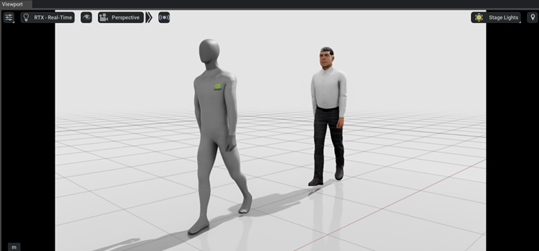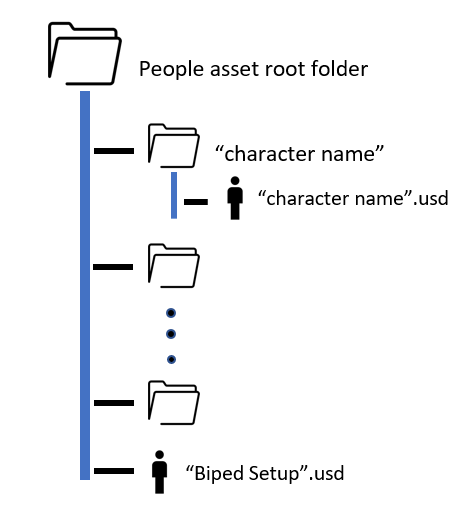Customization#
Overview#
Isaacsim.Replicator.Agent (IRA) supports custom environment assets, custom character assets, and custom character animations. This section will guide you through the process of setting up your custom assets for use in IRA.
Custom Environment Assets#
You are welcome to use your custom scene assets. To use custom environment assets, they must be in USD format and have the correct root layer attributes. This guide helps
you find environment assets, convert scene assets to .usd format, configure and light the scene, and create the Navigation Mesh
for the scene.
Find Environment Assets#
We recommend browsing the Content Browser for high quality assets that are ready-to-use for Omniverse.
You can also browse 3D asset stores like Turbosquid and Sketchfab. You can filter asset search on these sites by “USD” to find Omniverse-ready assets. Any non-USD environment asset you want to use must be converted to USD.
Converting Non-USD Assets to USD#
Omniverse offers a wide range of tools to convert your asset to USD. Follow the Omniverse Connections Overview for more information.
Configure the Environment Asset#
With your environment asset in USD format, you might want to adjust scale or lighting before importing it into Isaac Sim.
To use a custom environment asset with IRA, you must create a Navigation Mesh for it. This section aims to help you set up your new environment asset so it’s ready for the extension.
Unit and Coordinates System#
IRA assumes that the environment asset is using meter as the unit and Z-up as the world coordinate system.
With the environment asset open in Isaac Sim, go to the right panel and select the Layer tab. Click the “Root Layer”, and the properties of the “World” are shown in the bottom right Property panel.
Typically, using Isaac Sim to convert the unit and system is the easiest way to get consistent coordinates:
Open the Isaac Sim default empty stage.
Drag your asset into the Stage panel on the left side.
Isaac Sim automatically creates a new Xform for it and converts it to the right config.
Alternatively, you can change the World Axis to Z and Meters Per Unit to 1 from the Layer Metadata attribute under the Root Layer Property, which can be found as the below default image shows. After changing the numbers, the scene is rotated in the
wrong direction and in the wrong scale. You need to manually rotate and scale it to the right direction and size. To verify that the scene is in the right configuration, drag a character
into the stage and see if it matches the size and direction of the environment.

Note
Some scenes might be created without having real-world-scale in mind. For these assets, it is recommended to drag a character into the stage and scale the root xform of the environment asset according to how big it is compared to the scene.
Lighting the Environment#
Typically, the original lighting of an asset isn’t compatible with Isaac Sim after the conversion, or there might be no lighting at all. Follow the Omniverse lighting guide to create the lighting setup for your environment. We recommend starting with a Dome Light for your environment.
Custom Character Assets#
IRA supports using your own USD character assets. Custom characters must be retargeted to the NVIDIA biped character before animations can be correctly applied. Refer to Animation Retargeting for how to retarget a character. In addition, make sure the characters are in the same measurement (in meter) and have the same orientation (Z as up axis, -Y as forward axis) as our supplied characters if you want to use our animations.
IRA also expects the character folder to contain a list of sub-folders, where each sub-folder has only 1 USD inside (the character USD). Organize your custom character assets in this manner. Now you can set the character asset folder in the config file to your custom character assets folder and spawn custom characters. Review below image for the folder structure.
Import Unreal Characters#
The Unreal Engine Marketplace offers high-quality content that can potentially be used in IRA. In this section, we demonstrate how to enable Unreal characters for use in Isaac Sim.
Export characters from Unreal as USD. Refer to Unreal Engine Connector for details.
Import USD Unreal characters into Isaac Sim. Because Unreal characters are in centimeters and have a different skeleton hierarchy than the NVIDIA biped character, the following steps are required:
Run the following script in the script editor to scale characters from centimeters to meters.
Scale a character prim
1from pxr import Gf, Usd 2import omni.usd 3 4def convert_mesh(mesh_prim, scaleMatrix): 5 # convert points 6 points_attr = mesh_prim.GetAttribute("points") 7 if points_attr != None: 8 points = points_attr.Get() 9 for i in range(len(points)): 10 p = points[i] 11 p = scaleMatrix.Transform(p) # change unit 12 points[i] = p 13 points_attr.Set(points) 14 # convert extent 15 extent_attr = mesh_prim.GetAttribute("extent") 16 if extent_attr != None: 17 extents = extent_attr.Get() 18 else: 19 extents = None 20 if extents != None: 21 for i in range(len(extents)): 22 extent = extents[i] 23 extent = scaleMatrix.Transform(extent) # change unit 24 extents[i] = extent 25 extent_attr.Set(extents) 26 27def convert_transform(transform, scaleMatrix): 28 trans = transform.ExtractTranslation() 29 rot = transform.ExtractRotation() 30 trans = scaleMatrix.Transform(trans) # unit conversion 31 transform.SetTranslateOnly(trans) 32 transform.SetRotateOnly(rot) 33 return transform 34 35def convert_skeleton(skeleton_prim, scaleMatrix): 36 # Convert bind pose 37 bind_transforms_attr = skeleton_prim.GetAttribute("bindTransforms") 38 if bind_transforms_attr != None: 39 bind_transforms = bind_transforms_attr.Get() 40 if bind_transforms != None: 41 for i in range(0, len(bind_transforms)): 42 bind_transforms[i] = convert_transform(bind_transforms[i], scaleMatrix) 43 bind_transforms_attr.Set(bind_transforms) 44 # Convert rest pose 45 rest_transforms_attr = skeleton_prim.GetAttribute("restTransforms") 46 if rest_transforms_attr != None: 47 rest_transforms = rest_transforms_attr.Get() 48 if rest_transforms != None: 49 for i in range(0, len(rest_transforms)): 50 rest_transforms[i] = convert_transform(rest_transforms[i], scaleMatrix) 51 rest_transforms_attr.Set(rest_transforms) 52 # Convert retarget pose 53 retarget_transforms_attr = skeleton_prim.GetAttribute("controlRig:retargetTransforms") 54 if retarget_transforms_attr != None: 55 retarget_transforms = retarget_transforms_attr.Get() 56 if retarget_transforms != None: 57 for i in range(len(retarget_transforms)): 58 if i == 0: 59 retarget_transforms[i] = convert_transform(retarget_transforms[i], scaleMatrix) 60 else: 61 retarget_transforms[i] = convert_transform(retarget_transforms[i], scaleMatrix) 62 retarget_transforms_attr.Set(retarget_transforms) 63 # Convert default animation source 64 animation_source_attr = skeleton_prim.GetRelationship("skel:animationSource") 65 if animation_source_attr != None: 66 skeleton_prim.CreateRelationship("skel:animationSource") 67 68# From centimeter to meter 69scale_factor = 0.01 70character_root_prim_path = "[your character prim root]" 71 72scaleMatrix = Gf.Matrix4d(1.0) 73scaleMatrix.SetScale(scale_factor) 74 75character_root_prim = omni.usd.get_context().get_stage().GetPrimAtPath(character_root_prim_path) 76for prim in Usd.PrimRange(character_root_prim): 77 if prim.GetTypeName() == "Mesh": 78 convert_mesh(prim, scaleMatrix) 79 elif prim.GetTypeName() == "Skeleton": 80 convert_skeleton(prim, scaleMatrix)
Retarget the characters to NVIDIA biped character by following Animation Retargeting.
If the characters are correctly setup, they can replicate the movement of an NVIDIA biped character by running its Animation Graph.


Custom Character Animations#
omni.kit.commands.execute( 'CreateRetargetAnimationsCommand', source_skeleton_path='',
target_skeleton_path='',
source_animation_paths=[''],
target_animation_parent_path='',
set_root_identity=False )
